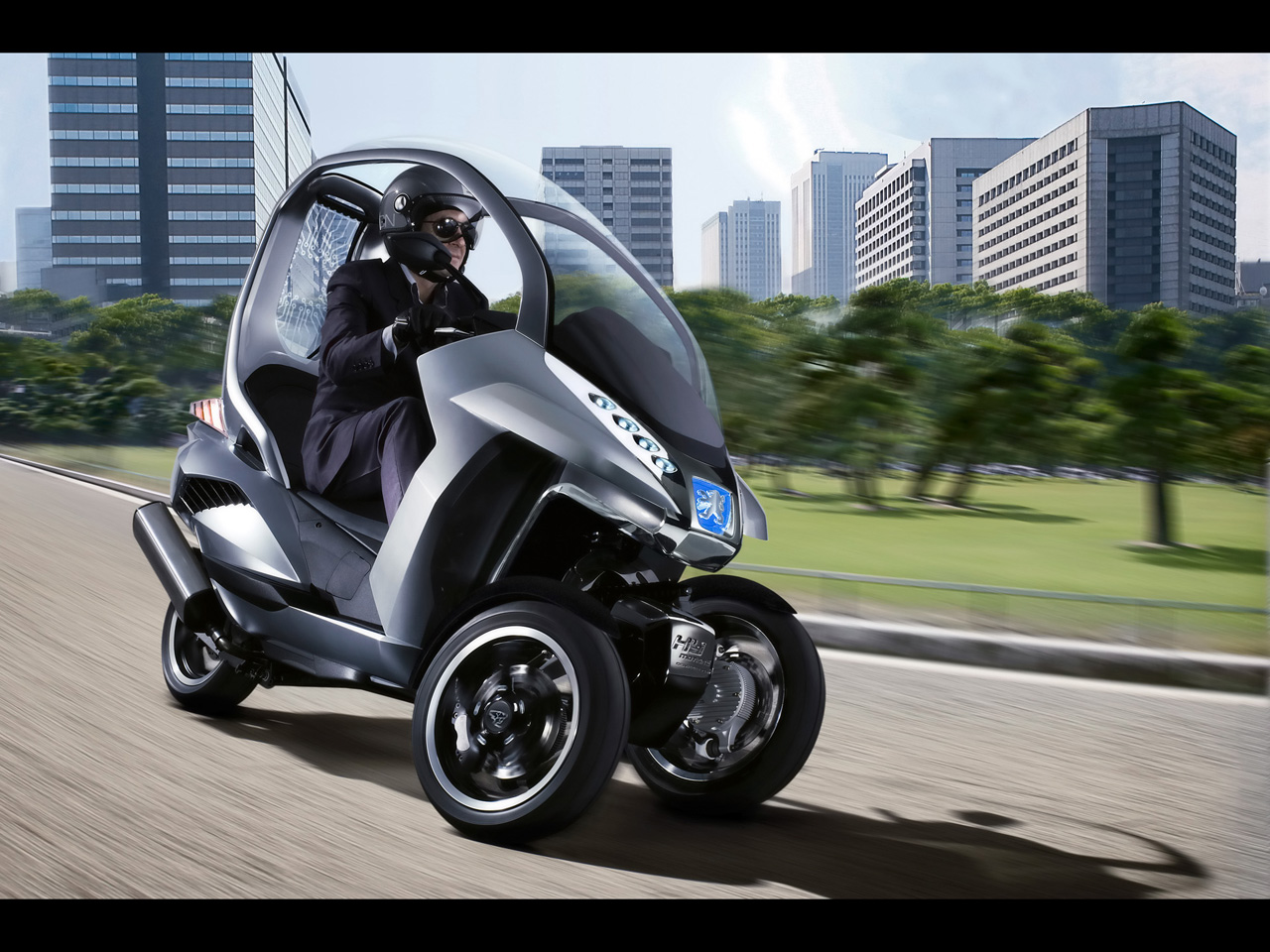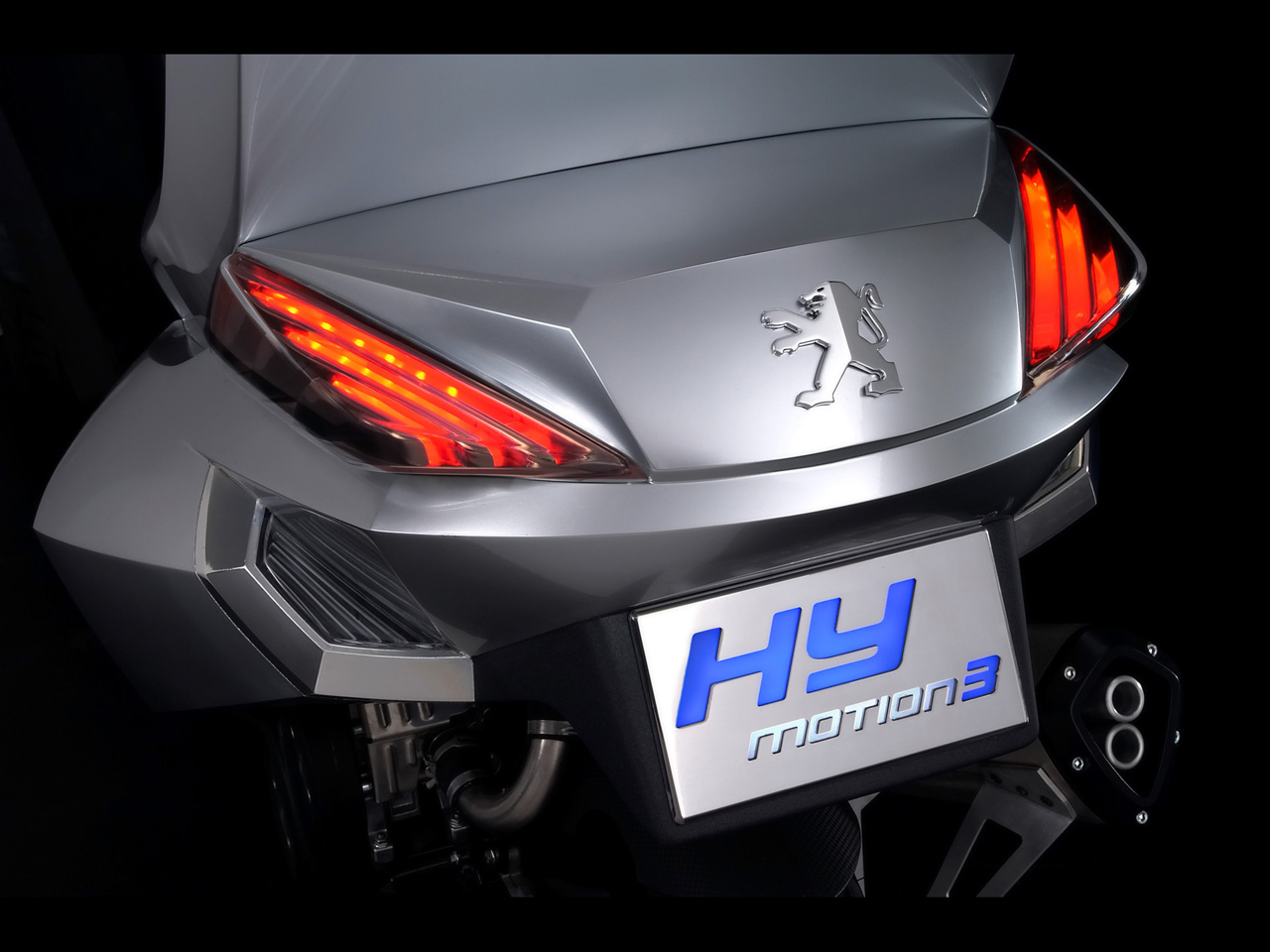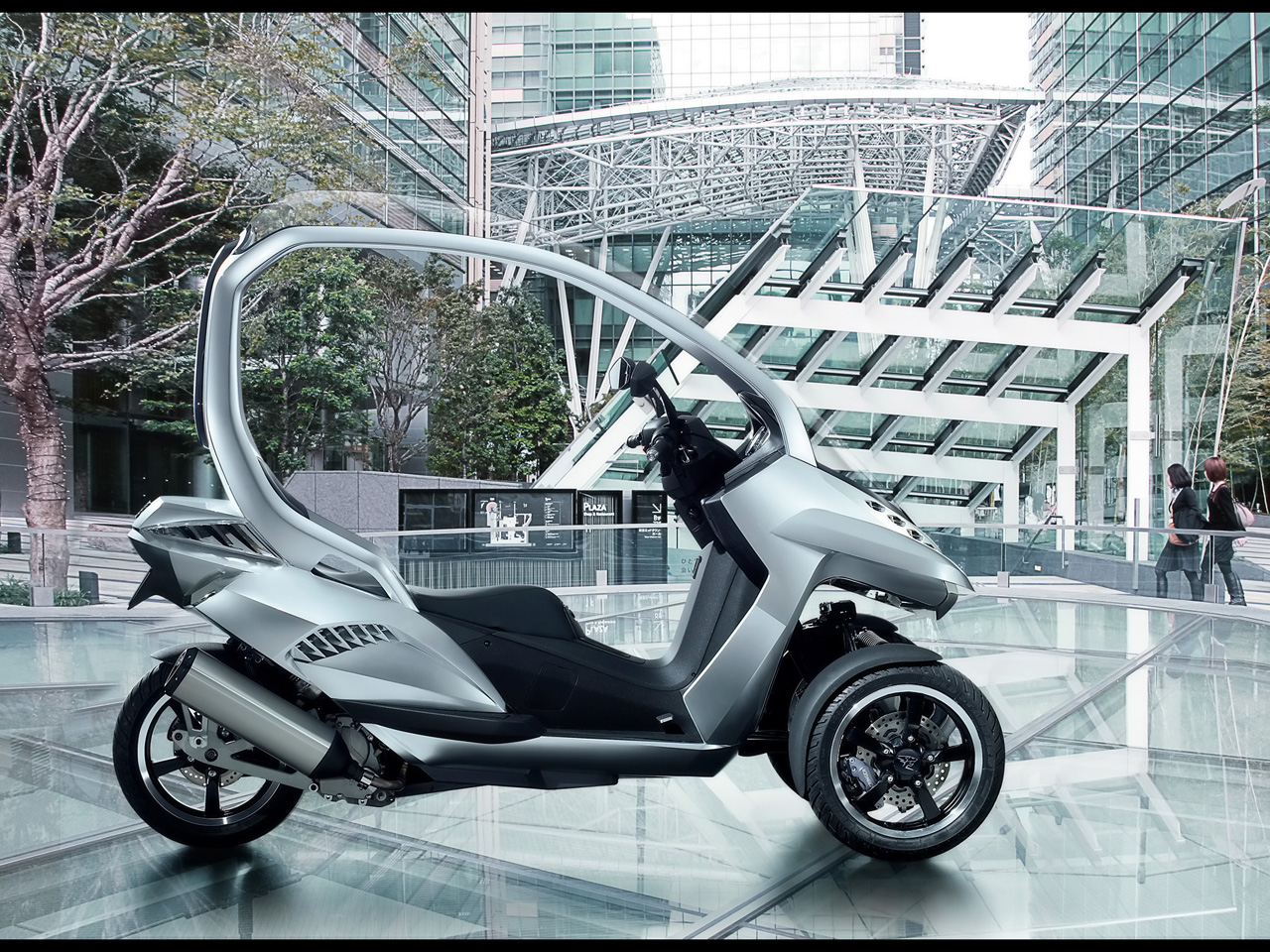2008 Peugeot HYmotion3 Compressor
|
Price |
-- |
Production |
-- | ||
|
Engine |
125 cc + 2 electric motors |
Weight |
551 lbs | ||
|
Aspiration |
supercharged |
Torque |
-- | ||
|
HP |
28 hp (total) |
HP/Weight |
-- | ||
|
HP/Liter |
160 hp per liter |
1/4 mile |
-- | ||
|
0-62 mph |
11.2 seconds |
Top Speed |
68 mph |
(from Peugeot Press Release) HYmotion3 compressor: The missing link
Occupying a half-way house between the world of the scooter and the car, the HYmotion3 compressor is a highly original proposal designed to facilitate urban mobility. Attractive thanks to its dynamic, streamlined and futuristic style ; it is an interesting concept combining numerous benefits (size, safety and comfort) with ''HYmotion'' hybrid/petrol technology. This new generation technology creates a three wheel drive vehicle, benefiting safety and driveability and combining economy with an environmentally-friendly specification (CO2 emissions of only 47 g/kph in the combined cycle, zero in electric only mode).
The HYmotion3 compressor concept is a means of transport with no affi liation to a particular type of vehicle. With its three wheels and its streamlined body, it is something of a missing link between two worlds which to date are quite distinct: that of the scooter and that of the car. With an electric motor in each of its two front wheels, coupled at the rear with a petrol engine, it brings into play very innovative hybrid technologies allowing each of its wheels to provide motive power.
In a world of intensifying urban traffi c where everyone is trying to save time, where oil prices are skyrocketing and the environment is more than ever a priority, design departments are vying in ingenuity to develop solutions for the future.
Giving full rein to
their creativity and expertise, two separate Peugeot teams converged
on a similar idea and finally worked in tandem to develop a
particularly original project: the HYmotion3 compressor.
This ''concept car'', or rather ''concept scooter'', is based on the
extensive experience of Peugeot Motorcycles, specialists in the
scooter fi eld, as well as the creativity and innovative
capabilities of stylists and engineers working for Automobiles
Peugeot.
To create this concept,
Peugeot was able to draw on its extensive experience in the world of
transportation enabling each individual, according to their age or
their needs, to choose from among the Marque's cycles, motorcycles
and cars.
This vehicle offers an ideal mix of the benefits of a scooter and
particular characteristics of a car.
Its design is based on three wheels for maximum stability, safety
and driveability. Its width of 82 cm enables it to thread a path
through urban traffic with all the efficiency of a two-wheeler. The
front windscreen extends to the rear of the vehicle to form a highly
effective shield against bad weather for the rider and passenger.
In addition, regulations in France allow the vehicle to be driven with a B licence only, giving it a wide range of potential customers.
Finally, this vehicle incorporates HYmotion technology, also featured on other concept-cars in the Peugeot exhibition space at the Paris Motor Show. This new generation hybrid technology incorporates the supercharged petrol engine already featured in the Peugeot Satelis scooter. With a power of 15 kW (20 bhp) driving the rear wheel, it is combined with two electric motors, each with an output of 3 kW, located in the front wheels.
This configuration develops a maximum power of 21 kW (29 bhp) for a particularly low fuel consumption of 2.0 litres/100 kph and CO2 emissions of 47 g/kph in the combined cycle, or 0 in electric only mode. The design of the HYmotion3 compressor, with its three wheel drive, provides positive benefits for both safety and driveability.
Thanks to its extreme
hybridisation, the HYmotion3 compressor concept creates a new
benchmark in terms of safety (improved traction and braking),
practicality and environmental-friendliness,
offering original versatility at one with its environment.
Style: Sharing ''DNA''
On the basis of a frame designed by Peugeot Motorcycles, Peugeot car stylists unveiled a resolutely sporty and avant-garde design which also captures the spirit of their latest creations, for example the 308 RCZ concept car.
Two polished aluminium roll-over bars support the ''bubble'' which protects the two occupants. This use of materials is strongly reminiscent of the RCZ concept.
These bars make a significant contribution to the vehicle's overall personality and balanced proportions. In addition to the comfort provided by this structure, the bars end in a handle which can be used by the rear passenger. To preserve the vehicle's clean lines, there are no rear-view mirrors, this function being carried out by two display screens on the instrument panel offering optimal rear vision.
Viewed from the front the vehicle creates a strong impression of modernity with its row of light emitting diodes (LEDs) on either side of the base of the front windscreen. These provide highly efficient lighting and also ensure that the vehicle can be seen easily in traffic.
Tapered front mudguards, strong lines and hi-tech rear lights… each detail adds to the dynamism of the HYmotion3 compressor. A dynamism which bears a strong resemblance to models in the Peugeot car range…
Operating principle: simple, efficient, automatic and transparent for the user
The vehicle's petrol engine has a power output of 15 kW (20 bhp). It is the supercharged 125 cc engine featured in the Peugeot Satelis scooter, this modern engine is widely acclaimed for its performance in its market segment.
In addition to this method of propulsion, the vehicle also has another mode of traction. Two electric motors, one in each wheel, are present at the front of the vehicle. With a power of 2 x 3 kW, they are powered by ''lithium-ion'' batteries and recharged by an energy recovery system which operates during deceleration and braking.
Therefore, there are no mechanical connections between the front and the rear, everything being controlled electronically (''by wire''), allowing optimisation of the available space.
The HYmotion3 compressor can therefore be ridden in a number of different ways:
--in electric only
mode (when starting up, at low speed and when decelerating, for
a range of up to 10 kph at stabilised speed),
--in petrol engine only mode, at a constant speed on the open
road, when the engine attains its optimal effi ciency,
--with the petrol engine / electric motors combined:
.... during phases of acceleration for additional power
(''boost'' function), the latter can attain a maximum of 15 + 3
x 2 = 21 kW (29 bhp),
.... in three wheel drive mode, when road conditions warrant it.
In fact, the layout of this electric/petrol hybrid system allows three wheel drive under all circumstances, benefi ting safety and driveability.
This hybrid technology, as well as its special innovative layout, is an important vector of research and development for Peugeot. Known internally as ''HYmotion'', this system is presented in multiple formats, featuring different types of engine, on Peugeot's stand at the Paris Motor Show. This concept demonstrates that the technology can be installed in any type of vehicle. In addition, different types of conventional engine can be combined with different types of electric motor.
HYmotion technology in this case is particularly miniaturised to ensure an environmental performance of the highest order.
The suspension and the
structure are designed to take account of this technology's
application.
The parallelogram type front suspension (i.e. with tilting wheels)
has a transverse damper at its centre and ensures optimal
driveability and vehicle stability. These technical components
are located on the wheel hubs, therefore reducing the vehicle's
centre of gravity following the example of the low-slung tubular
frame.
Braking, rendered more efficient by the presence of an ABS system, it relies on three ventilated discs and, above all, the front electric motors, which recover energy to recharge the batteries. This assembly (three wheels + electric motor braking) also reduces the braking distance by around 30% compared to a two-wheel scooter equipped with traditional brakes.
Another system contributing to the vehicle's efficiency is the STOP & START system. This system switches the petrol engine to standby mode during stop phases (at a red traffic light or a stop sign, in queuing traffi c, etc.) or when the vehicle is being driven in electric only mode. This allows significant gains in terms of fuel consumption and emissions, particularly in dense traffic conditions. It also allows the petrol engine to be restarted instantaneously and ''transparently'' for the driver when necessary. Note that when being driven in electric only mode, the HY motion 3 compressor is ideally suited to city use since it generates no CO2 emissions or pollutants and is silent in operation.
The end result is a three-wheel drive vehicle offering reduced fuel consumption in the combined cycle of 2.0 litres/100 kph and CO2 emissions of 47 g/kph!
Performance doesn't suffer either, since with a maximum power of 21 kW (29 bhp), its acceleration and in-gear acceleration is equivalent to what would have been possible with a single cylinder 400 cc engine.
Here too, the hybridisation of technologies makes it possible to combine the benefi ts of an ultra-compact urban vehicle with three-wheel drive, while at the same time offering environmentally-friendly credentials.
Environmentally-friendly and efficient technologies: research goes on
To tackle the problem of greenhouse gas emissions, and with the prospect of fuel prices rising ever higher, Peugeot has made the reduction of fuel consumption and CO2 emissions a key facet of its product policy, both with regard to motor cars and motorcycles.
In fact Peugeot is making a key contribution to the position of the PSA Peugeot Citroën group as a world leader in the market of cars with a rate of CO2 emissions below 120 g/kph.
In the market for
motorised two-wheelers, Peugeot Motorcycles is also very much to the
fore.
Peugeot Motorcycles has been innovating since 1996 when it launched
the Scoot'Elec, the market's first compact electric scooter.
In 2002, Peugeot Motorcycles developed and perfected engines with electronic fuel injection in line with the strictest anti-pollution standards, thereby helping to reduce fuel consumption and CO2 emissions while improving performance and driveability.
In 2006, weight and
aerodynamic tests carried out in the wind tunnel saw the Satelis
scooter obtain the best SCx on the market and, as a result, offer
one of the lowest fuel consumptions in its segment.
Since 2008, Peugeot Motorcycles has included a 50 cc, 4-stroke
scooter in its range offering particularly low fuel consumption, the
V-Clic.
With HYmotion technology, benefi ting from experience derived from previous technological demonstrators (307, 307 CC and 308 Hybrid HDi), the HYmotion3 compressor represents a major advance in terms of ''customer'' benefits. These benefits include: safety, driveability, economy and also environmental-friendliness.



